The construction of the Big Four Railroad, then known as the “Bee Line” in Hancock County, was indirectly responsible for the establishment of St. Thomas the Apostle Parish in Fortville.
The railroad was completed in 1850 by laborers of Irish descent. In 1866, one of the first priests to take a deep interest in the new congregation was the Reverend Father Bessonies, pastor of St. John’s Parish in Indianapolis .
When the possibility of building a church arose, several suggestions were made that it be built in Woodbury, but it was eventually decided that Fortville showed more possibilities of growth.
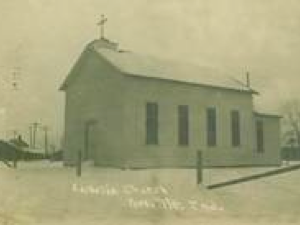
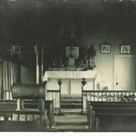 Ground for the church was donated by James E. Merrill in 1868 on the site of which the present church stands. In 1869, a frame church was built under the supervision of Reverend Father Denis McMullen of St. John’s , Indianapolis , and completed and dedicated by Father Crowley of St. Mary’s Church, Anderson.
Ground for the church was donated by James E. Merrill in 1868 on the site of which the present church stands. In 1869, a frame church was built under the supervision of Reverend Father Denis McMullen of St. John’s , Indianapolis , and completed and dedicated by Father Crowley of St. Mary’s Church, Anderson.

Records of parishioners at this time show names like Kelly, Boucher, McMahan, Tobin, Corey, List, McCord, McColley, Durack, Busey, Dugan, and Callahan.
For a few years, there was no resident pastor at St. Thomas , at that time called St. John. Services were conducted by visiting priests from St. John’s , Indianapolis , and St. Mary’s, Anderson.
In 1877, the Franciscan monastery in Indianapolis was given charge of the congregation. The first Franciscan pastor was Fr. Arsenius Fahle.
There was a Ladies’ Altar Society, organized after the building of the church. Its purpose was to help with the purchase of altar linens, vestments and the cleaning and upkeep of the altar and the church.
There was also a League of the Sacred Heart, organized in 1913, with the aim to encourage a greater devotion to, and love of, the Sacred Heart of Jesus, furthering a closer union in prayer.
 In 1916, the parish, consisting of about 60 members, undertook the building of the present brick structure. Leaders of the parish, who also composed the building committee, were James Ganley, Lawrence Durrack, P.J. Kelly and Thomas Tobin. Local builder, Frank Crouch, built the new church and Brother Christopher superintended the construction. The cost of building the church was $7,113.67.
In 1916, the parish, consisting of about 60 members, undertook the building of the present brick structure. Leaders of the parish, who also composed the building committee, were James Ganley, Lawrence Durrack, P.J. Kelly and Thomas Tobin. Local builder, Frank Crouch, built the new church and Brother Christopher superintended the construction. The cost of building the church was $7,113.67.
The frame structure was moved to Michigan Street and still stands as a residence.
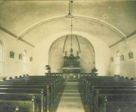 The altar was carved by hand of cherry wood by Franciscan monks near the Black Forest in Germany and shipped to Fortville in two pieces. The hand carved Communion rail followed one year later. We have relics in the back altar, but we are unsure whose relics they are.
The altar was carved by hand of cherry wood by Franciscan monks near the Black Forest in Germany and shipped to Fortville in two pieces. The hand carved Communion rail followed one year later. We have relics in the back altar, but we are unsure whose relics they are.
The stained glass windows were also donated by parishioners. They were made by hand at the Emil Frie Glass Works in St. Louis . It is said that all the windows were bought for $500. Each of the windows has ne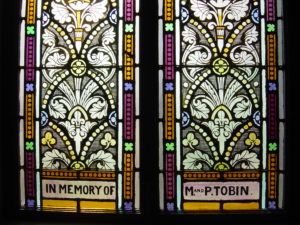 ar its top a richly colored piece of artistry symbolizing one of the cherished truths or traditions of the Catholic Faith.
ar its top a richly colored piece of artistry symbolizing one of the cherished truths or traditions of the Catholic Faith.
The statuary in our church is especially valuable. The statues of a sorrowful Mary and St. John are standing at the foot of the cross. A statue of the Sacred Heart is on the left side of the altar, St. Joseph is on the right and St. Thomas is standing in the right front of the church. All the statues, indeed the entire church building, were purchased, or built, with funds donated by the early parishioners. The statues of the Sacred Heart and the Blessed Virgin were made by the Daprato Statuary Company in Italy . The molds were later destroyed, making them irreplaceable!
In 1920, the St. Ann ‘s Club was established. Its purpose was to be a social group that would raise money to help purchase things needed for the new church. In 1926, the Stations of the Cross were purchased by the St. Ann ‘s Club for $433.95. In 1928, the club purchased a car for Fr. Ethelbert for $125, so the priests no longer needed to ride the trains out to Fortville.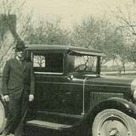
In 1929, the club bought the confessional for $185.41 and, in 1931, it purchased the Crucifix above the altar for $75. St. Ann ‘s Club also paid for the painting of the church, in 1934.
St. Thomas remained a Franciscan mission until 1934. Some of the early Franciscan priests were Fr. Pete, Fr. Tom, Fr. Theodore, Fr. Ethelbert and Fr. Herbert. In 1934, a pastor was appointed by Bishop and later Cardinal Joseph Ritter for Fortville and Greenfield , with his residence in Greenfield .
Fr. John Reidenger was appointed pastor from 1934-1938. He was followed by Fr. Thomas Kilfoil, Fr. Dennis Spalding from 1938-1947, and Fr. Dennis Nolan from 1947-1951.
In 1951, the parish became a mission of St. Lawrence Church in Indianapolis , and Fr. Robert Minton served the parish.
The next year brought the parishioners their parish hall. The old Prentice Presbyterian Church, on 38 th St. in 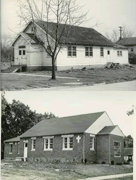 Indianapolis , was purchased for $3500, dismantled, brought to the church grounds, reconstructed and bricked. Most of the work was done by the men of the parish and Fr. Minton. The building committee for the hall consisted of Tom Kelly, Claude Boucher, Bud McMahon, Julius Wittman, Clarence Garst and Ray Kellermeyer. The hall was dedicated in June 1952 by Archbishop Paul Schulte.
Indianapolis , was purchased for $3500, dismantled, brought to the church grounds, reconstructed and bricked. Most of the work was done by the men of the parish and Fr. Minton. The building committee for the hall consisted of Tom Kelly, Claude Boucher, Bud McMahon, Julius Wittman, Clarence Garst and Ray Kellermeyer. The hall was dedicated in June 1952 by Archbishop Paul Schulte.
The regular Religious Education Program began in February 1953. The first lay teachers in the program were Emma Rader, Irene Mosele, Gladys Alfonte, Mary Bednarski, Mary Weir and Loretta Copeland, who all taught preschool and elementary instruction. Cpt. Gallagher, from Ft. Benjamin Harrison, taught secondary lessons.
Still a mission of St. Lawrence, the parish was served by Fr. John Stahl and Fr. Ralph Stasshelm from 1953-1961. In 1960, the parish bought the rectory in preparation for our first resident pastor, for about $6200. Designated an independent parish in 1961, the first resident pastor was Fr. Joseph Koster. 1961 marked the first time in the parish’s history that two Sunday masses and weekday masses were celebrated.
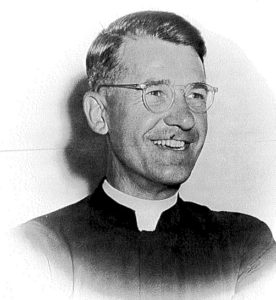 In 1966, Fr. Matthew Herold came to St. Thomas as pastor.
In 1966, Fr. Matthew Herold came to St. Thomas as pastor.
In March 1967, the new front altar was dedicated. The altar and new carpeting in the church were donated by the Women’s Club.
1971 brought another new pastor, Fr. Francis Touhy. 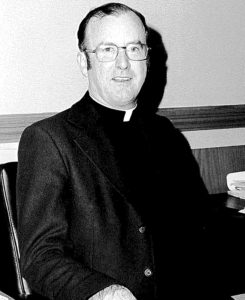
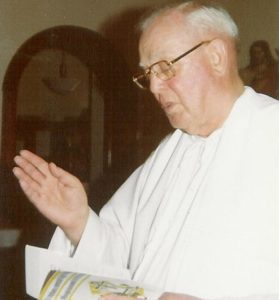 Fr. Paul Utz became pastor in 1974.
Fr. Paul Utz became pastor in 1974.
 In 1982, Fr. Joseph Kos became our new pastor. He was instrumental in organizing our new Parish Council and committees that fall under its realm. Another group was also organized called The Friends of St. Thomas . This group was committed to raising funds for various needs of the church. This group started a bingo, along with the Fortville Optimist Club. The games were held at St. Thomas , but were closed down in 1984 because the state police raided the games one night. They arrested Fr. Kos and the past president of the Optimist Club. Fr. Kos decided to close the bingo to stop further controversy.
In 1982, Fr. Joseph Kos became our new pastor. He was instrumental in organizing our new Parish Council and committees that fall under its realm. Another group was also organized called The Friends of St. Thomas . This group was committed to raising funds for various needs of the church. This group started a bingo, along with the Fortville Optimist Club. The games were held at St. Thomas , but were closed down in 1984 because the state police raided the games one night. They arrested Fr. Kos and the past president of the Optimist Club. Fr. Kos decided to close the bingo to stop further controversy.
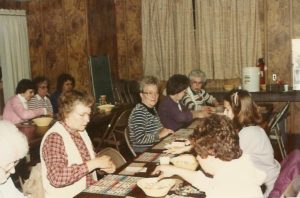
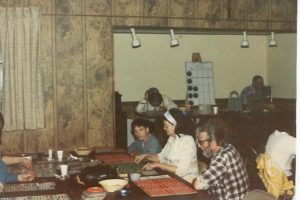
In 1983, the first annual summer festival was held. It began with a few members of the parish meeting at John Lutchka’s house to plan the event. There was a food booth and about 10 game booths that first festival. We now hold the festival annually the first Saturday of August.
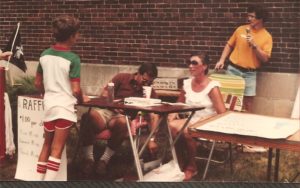
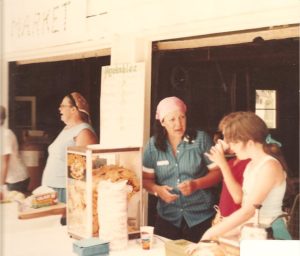
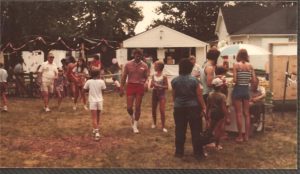
In 1984, an addition was made to the existing hall. We gained six classrooms for our religion classes. The building committee consisted of: Bill Garst (chairman), John Lutchka (vice chairman), Ron Chambers, Pat Dalton, Mike Douglass, Tony Garst, Gordon Griffard, Don Hanson, Connie Marten, Tim Ryan, Tim Shaw, and Fr. Kos. The Finance Committee for the activity center was Paul Nobbe (chairman), Dick Dillon, Joann Fox, David Garst, Fred Schramm, and Fr. Kos. Tom Marten was the general contractor and the total cost of the building was $141,680.69. Archbishop Edward T. O’Meara dedicated the building on November 18, 1984.
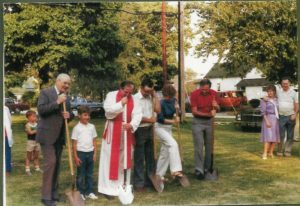
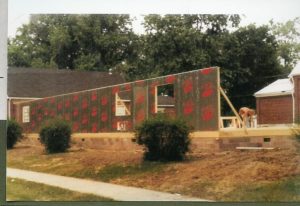
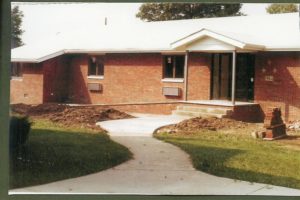
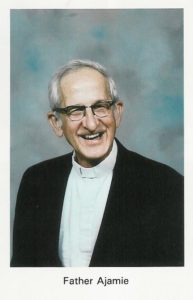 In July of 1989, Fr. Albert Ajamie became our pastor. In 1991, Fr. Ajamie had the communion rail sent to Weberding’s Carving Shop, Inc. to be made into the present front altar, lectern, and screen for the new Reconciliation Room. The cost of this project was $4,977.73. Also during that year, the parish began
In July of 1989, Fr. Albert Ajamie became our pastor. In 1991, Fr. Ajamie had the communion rail sent to Weberding’s Carving Shop, Inc. to be made into the present front altar, lectern, and screen for the new Reconciliation Room. The cost of this project was $4,977.73. Also during that year, the parish began
two new ministries: the Nursing Home Ministry and the Parents Day Out Program. The handicap ramp was built and the front steps and landing were reconstructed in 1992, for the cost of $10,000. By 1993, the Parents Day Out Program expanded into The Little Lamb’s Preschool.
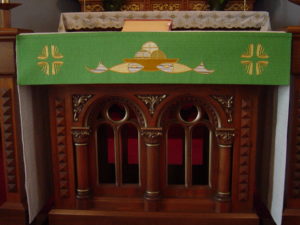
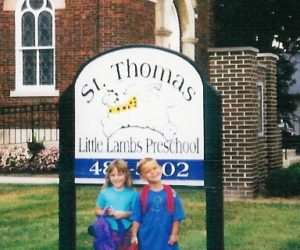
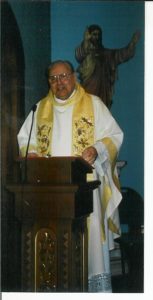 Father Roger Gaudet became pastor at St. Thomas in 1994.
Father Roger Gaudet became pastor at St. Thomas in 1994.
In 1995, the cry room was built by enclosing the back left corner of the church. The CYO was reorganized and became Youth Ministry in 1996. The parish purchased property across Garden Street in 1996 and again in 2000, which is used for overflow parking. In 1998, the Little Lamb’s Preschool was closed. The existing garage was beginning to deteriorate, so the parish undertook the building of a new garage in 1999, under the leadership of Paul Nobbe.

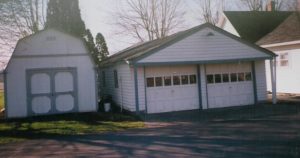
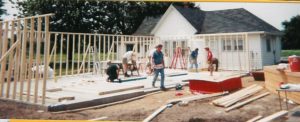
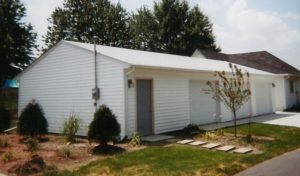
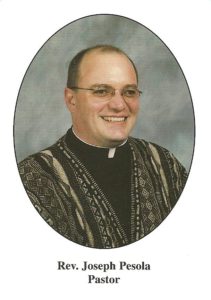 In July of 2002, Fr. Joseph Pesola became the administrator of St. Thomas.
In July of 2002, Fr. Joseph Pesola became the administrator of St. Thomas.
The statue for pro-life was donated by an anonymous donor in 2003.
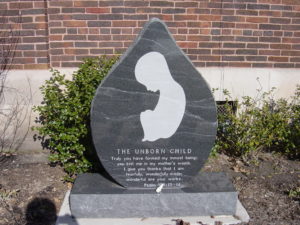
In 2004 we had the interior of the church repainted, in 2006 we replaced the organ, in 2007 we had the church reroofed. Also in 2007, Deacon Frank Klauder joined St. Thomas and became our permanent Deacon. A renovation of the rectory which included some wall repairs, new carpeting and a complete repainting of the interior was done in 2008. New kneelers were purchased in July of 2011 for $5,324.50 and the piano was replaced by a new Clavinova in February of 2012.
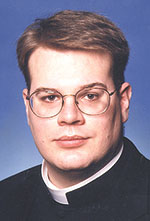 Fr. McCarthy was appointed pastor in December of 2012.
Fr. McCarthy was appointed pastor in December of 2012.
Then Fr. George Nangachiveettil was appointed pastor in July of 2013.
We purchased 5.1 acres of more ground across Garden Street in 2013.There were 2 Eagle Scout projects done in 2013 for the betterment of St. Thomas. In July they made all new game booths for our annual Festival and later in the year a Prayer Garden was completed behind the garage and rectory. 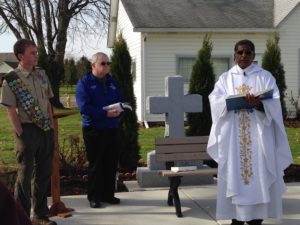
The chimney on the church was removed due to a leaking problem in 2015. At the same time, due to water damage in the church, we had the church tuck pointed, new down spouts and gutter work done and had the old Plexiglas protectors taken off the stained glass windows on the south and west sides of the church. Parishioners of St. Thomas and the Knights of Columbus worked on replacing that protection for the stained glass windows.
New sanctuary chairs and a celebrant chair was donated in 2016 in the memory of Harry & Estelle Cairns.
In September of 2016 we celebrated the Anniversary of our Church building being 100 years old. All year long we did various activities to build excitement and at the end of September, then Archbishop Joseph Tobin, now Cardinal, came out and celebrated Mass with us. 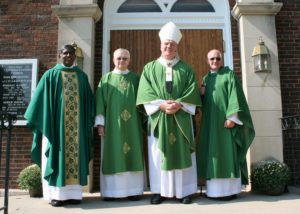
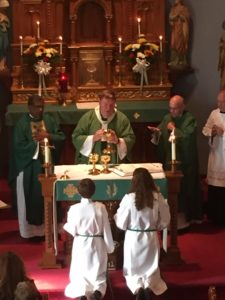
Once the repairs were complete, with the generous donation of a parishioner, we had the interior of the church painted and new carpet throughout the church and had the statues cleaned and refurbished the summer of 2017.
Our parish has flourished many years with the help and hard work of many volunteers and staff. There have been so many through the years that we could not list them all. We have had excellent secretaries and AREs who have taken care of our children and the everyday running of our parish. Many people who have volunteered as catechist and devoted many hours to their classes. Youth ministers, who also minister to our children. Those who have helped with music and liturgical ministries at mass. The cleaning and upkeep of the grounds, such as lawn care. Parishioners who have joined committees to help with the different areas of service to our parish. Volunteers who have taken communion to our sick and home bound. All the many people who take on the major undertaking of our Annual Festival.
We are also excited to have a Deacon from our own parish be ordained in 2017-Deacon Tony Lewis. He will be another valuable asset to our Liturgy and service to our parish. 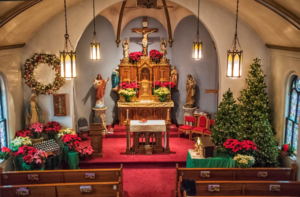
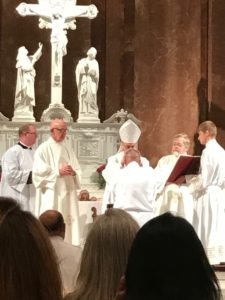
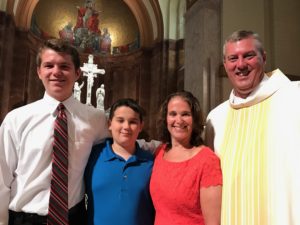
St. Thomas is now 225 families strong, with flourishing parish involvement. We have a growing and respected Religious Education Program, a strong Parish Council and committees, Youth Ministry, Women’s Club, St. Ann ‘s Club and Knights of Columbus. We are excited about our future as a parish, and our role in the growing community